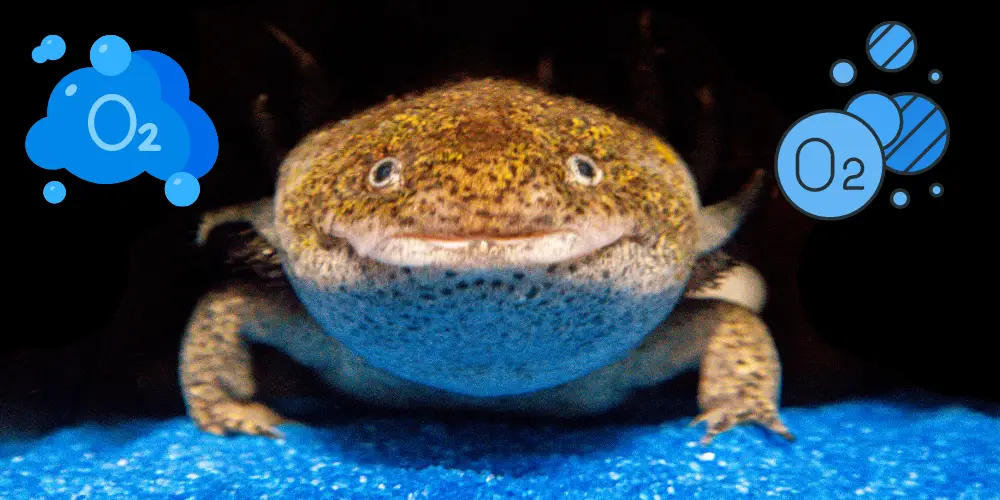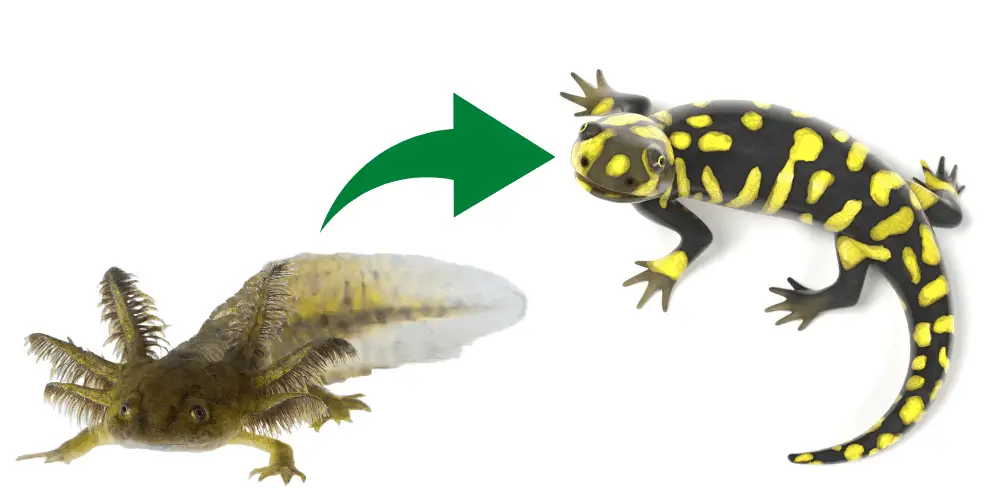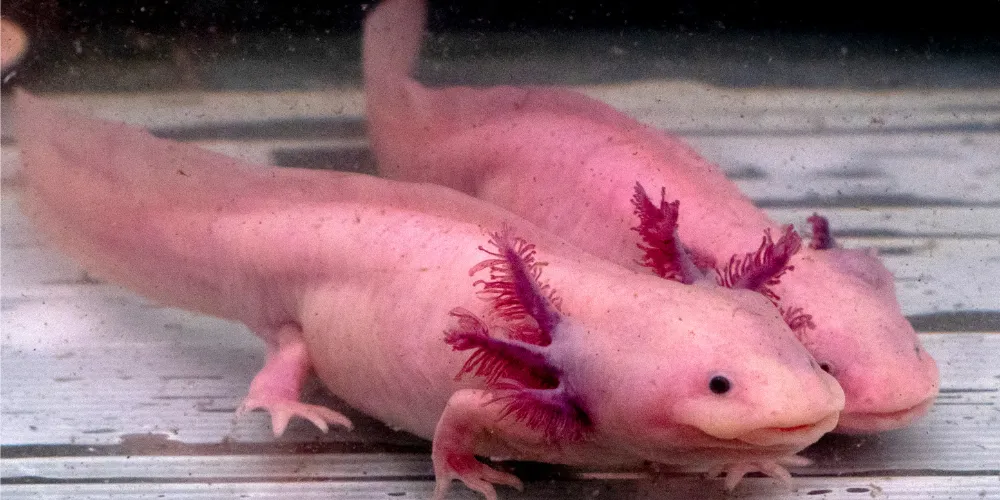Axolotls, often called the “Mexican walking fish,” have long fascinated biologists and pet enthusiasts alike with their unique amphibious nature. A common question when discussing these creatures is, “Can axolotls breathe air and survive on land?”
Axolotls can breathe air using their lungs but primarily rely on their gills for oxygen extraction in water. They are aquatic and should not be kept out of water for extended periods.
This article delves deep into the biology of axolotls to answer this intriguing question.
Key Takeaways
- Axolotls primarily rely on their gills for oxygen extraction in water, but they also possess lungs for breathing air as a secondary mechanism.
- Axolotls are not suited for prolonged periods outside water due to challenges like drying respiratory organs, loss of protective slime coat, risk of dehydration, and stress.
- Axolotls’ skin respiration is secondary to gills, unlike many other amphibians which use their skin for significant respiration.
- Neoteny is a unique trait in axolotls, where they retain their aquatic juvenile features throughout their lives, unlike other amphibians that undergo metamorphosis.
- Axolotls’ limbs are adapted for aquatic movement, making them ill-suited for walking on land despite their appearance.
- When handling axolotls, wet hands, gentle touch, and minimal contact are essential to prevent stress and skin damage.
- Axolotls’ ability to regenerate body parts is remarkable, but there are limits to their regenerative capabilities.
- Misconceptions about axolotls include their ability to live exclusively outside water, undergo full metamorphosis, and walk on land like frogs.
- Axolotls offer a unique glimpse into biology, reminding us of the responsibilities of caring for these exceptional creatures.
- Respect for axolotls’ aquatic nature, understanding their dual respiratory system, and promoting their well-being is crucial in their conservation and pet ownership.
Breathing Mechanisms of Axolotls
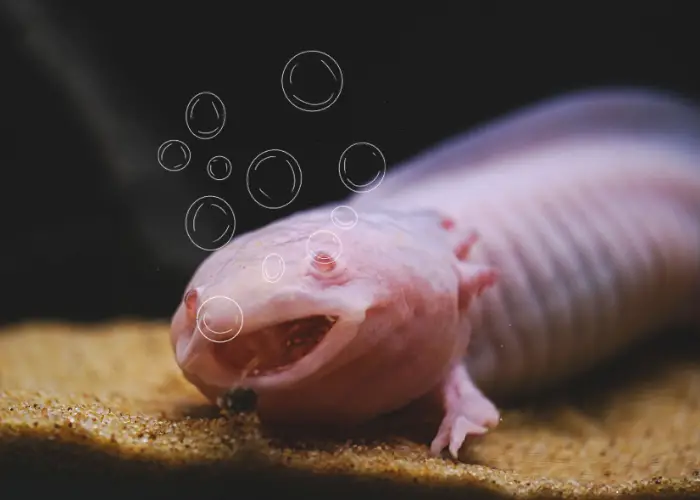
Dive into the world of axolotls, and you’ll discover a respiratory marvel. These amphibian wonders boast a dual breathing system, seamlessly extracting oxygen from water and air.
1. Feathery Gills: Nature’s Respiratory Masterpiece
- Position: Elegantly draped behind their heads.
- Appearance: Delicate pink fronds that are more than just ornamental.
- Function: Packed with blood vessels, these gills are the axolotl’s primary oxygen source. As water sweeps over, oxygen diffuses in, and carbon dioxide wafts out.
2. Lungs: The Backup Breathers
- Anatomy: A pair of lungs, akin to many land-dwellers.
- Usage: In oxygen-scarce waters, axolotls surface to gulp air, filling these lungs.
- Occurrence: Mostly observed in stagnant waters or areas with minimal water movement.
While their lungs offer a breathing backup, axolotls predominantly rely on their gills. For those housing these creatures, ensuring a clean, oxygen-rich aquatic environment is paramount for their thriving existence.
Comparative Analysis: Axolotls vs. Other Amphibians:
| Feature/Characteristic | Axolotls | Other Amphibians |
|---|---|---|
| Metamorphosis | Axolotls do not undergo a typical metamorphosis. They retain their aquatic juvenile features throughout their lives, a phenomenon known as neoteny. | Most amphibians undergo metamorphosis, transitioning from a larval stage (like tadpoles) to an adult form that can live both in water and on land. |
| Primary Respiratory Organ | Axolotls primarily rely on their gills for respiration. | While many amphibians also have gills during their larval stage, they transition to lungs as their primary respiratory organ in their adult form. |
| Skin Respiration | Axolotls do use their skin for respiration, but it’s secondary to their gills. | Many amphibians, especially in their adult form, use their skin as a significant respiratory organ, supplementing their lung-based breathing. |
This table highlights the unique characteristics of axolotls in comparison to other amphibians, emphasizing their distinct evolutionary adaptations and biological features.
The Amphibious Nature of Axolotls
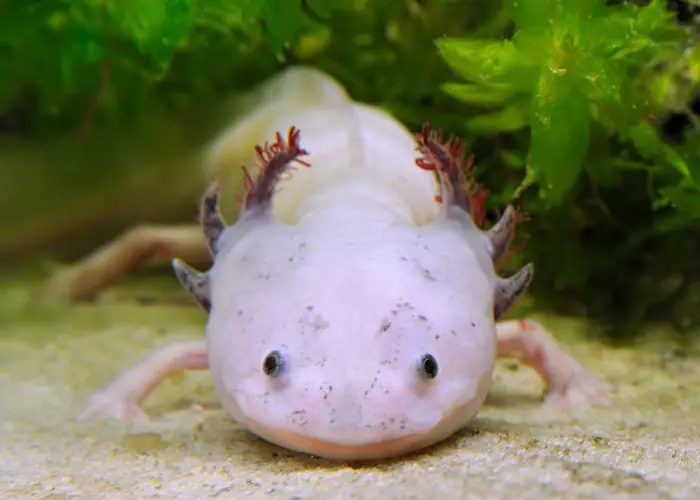
When one hears the term ‘amphibian,’ images of creatures transitioning between water and land often come to mind. Frogs are leaping from ponds to grassy banks or newts crawling from streams to underbrush. However, axolotls dance to a different tune in the amphibian world.
Not Your Typical Amphibian:
- Classification: While axolotls fall under the amphibian umbrella, they diverge from the typical amphibian narrative. They don’t undergo the usual metamorphosis that sees creatures like frogs transition from tadpoles to land-dwelling adults.
- Aquatic Affinity: Axolotls have an undying allegiance to their watery homes. Their entire biology screams aquatic adaptation, from feathery gills to slender, fin-like limbs.
Why Land is a No-Go:
- Delicate Design: While perfect for gentle aquatic navigation, their limbs lack the robustness required for terrestrial movement. Their soft, permeable skin is also more susceptible to dehydration and injury outside water.
- Respiratory Reliance: Axolotls primarily rely on their gills for oxygen, which function optimally in water. Without the constant water flow over their gills, they’d struggle to breathe efficiently on land.
In the grand tapestry of nature, axolotls stand out as a testament to creations’ quirks and wonders.
Their life, deeply intertwined with the water they inhabit, reminds them of the diverse paths life can take, even within a single classification like ‘amphibian.’
Axolotls on Land: What Happens?

Axolotls are truly aquatic creatures, and their physiology is adapted for life submerged in water. When these fascinating amphibians are taken out of their aquatic environment, several physiological and health challenges arise:
- Duration Outside Water:
- Axolotls can survive outside of water for a limited time, typically a few hours. However, this duration can vary based on environmental conditions such as humidity and temperature.
- Respiratory Challenges:
- The moist skin and gills of axolotls are essential for their breathing. These respiratory organs begin to dry out when exposed to air for extended periods. As they dry, gas exchange efficiency reduces, making it increasingly difficult for the axolotl to breathe.
- Protective Slime Coat:
- Axolotls have a protective slime coat covering their skin. This mucus layer serves multiple purposes, including warding off pathogens and aiding in respiration. When axolotls are out of water, this slime coat starts to diminish. As it reduces, the axolotl becomes more vulnerable to infections and diseases.
- Risk of Dehydration:
- The moist environment of water is crucial for axolotls. When on land, they risk dehydration, which can lead to severe health complications and, in extreme cases, can be fatal.
- Stress and Discomfort:
- Being out of their natural habitat is highly stressful for axolotls. Prolonged exposure to such stress can weaken their immune system and make them more susceptible to illnesses.
While axolotls can breathe air using their lungs, they are not adapted for extended periods outside of water. Their well-being needs to minimize their time out of their aquatic environment and ensure they are returned to water promptly.
Handling Axolotls: Dos and Don’ts

While axolotls are captivating creatures, handling them outside water can be detrimental. Their delicate skin is easily damaged, and they’re prone to stress. If you must move or take an axolotl, there are specific guidelines one should adhere to:
- Dos:
- Wet Hands: Always ensure your hands are clean and wet before handling an axolotl. Wet hands reduce the friction and prevent the removal of the protective slime coat on the axolotl’s skin.
- Gentle Touch: When lifting or moving an axolotl, use a soft and gentle touch. Avoid squeezing or applying pressure, as their bodies are delicate.
- Short Duration: If you need to handle them, make sure it’s for a brief period. Prolonged exposure to air can be stressful and harmful to axolotls.
- Use a Soft Net: If you need to transfer an axolotl from one tank to another, consider using a soft net to minimize direct handling.
- Don’ts:
- Avoid Frequent Handling: Axolotls are not pets that enjoy being handled frequently. Observing them in their aquatic environment and limiting direct contact is best.
- Don’t Use Chemicals: Ensure that no lotions, soaps, or chemicals are on your hands when handling axolotls. These can be toxic to them.
- Avoid Rough Surfaces: Never place axolotls on rough or abrasive surfaces, as this can cause injuries to their soft skin.
- Don’t Disturb During Molting: Axolotls occasionally shed their skin. It’s crucial not to handle them during this period as their new skin is exceptionally delicate.
- General Care:
- Monitor Water Quality: While this isn’t directly related to handling, ensuring that the water quality in their tank is optimal will reduce the need for frequent handling or transfers.
- Provide Hiding Spots: Axolotls appreciate having places to hide in their tank. This reduces their stress levels and provides them with a sense of security.
While axolotls are enchanting creatures, they thrive best with minimal direct handling. Respecting their needs and boundaries ensures they lead a healthy and stress-free life.
Common Misconceptions and Myths
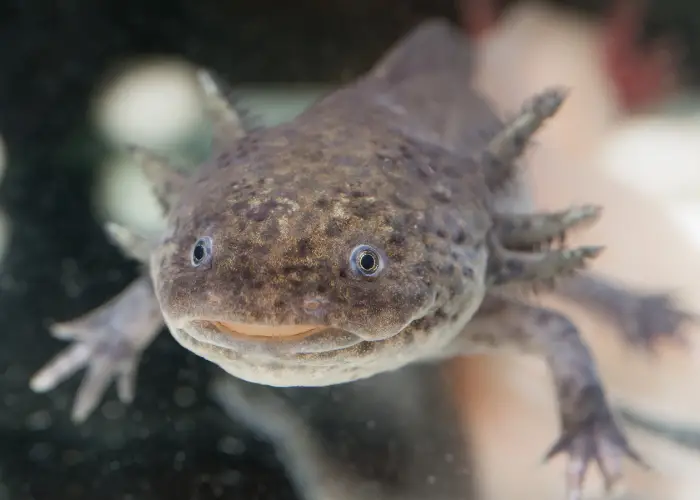
With their alien-like appearance and unique biological features, Axolotls have been the subject of numerous myths and misconceptions.
These often arise from genuine curiosity, partial truths, and folklore. Let’s delve into some of the most common misconceptions and the facts behind them:
- Walking on Land:
- Myth: Axolotls can walk on land just like any other amphibian.
- Reality: While axolotls have legs that might suggest they can walk on land, they are primarily aquatic creatures. Their limbs are more suited for navigating the water and are not adapted for terrestrial movement.
- Breathing Mechanism:
- Myth: Axolotls can breathe exclusively out of water like frogs or toads.
- Reality: While axolotls possess lungs and can breathe air to some extent, their primary respiratory organ is their gills. Relying solely on their lungs for extended periods can be detrimental to their health.
- Life Outside Water:
- Myth: Axolotls can live outside water, similar to other amphibians.
- Reality: Axolotls are adapted to an aquatic life. Keeping them outside their watery habitat for extended durations can lead to dehydration, stress, and can be fatal.
- Metamorphosis:
- Myth: Like other amphibians, axolotls undergo a complete metamorphosis, transitioning from a water-dwelling larva to a land-dwelling adult.
- Reality: Axolotls exhibit a phenomenon called neoteny, where they retain their juvenile aquatic characteristics throughout their lives. They do not undergo the typical metamorphosis seen in other amphibians.
- Regenerative Powers:
- Myth: Axolotls can regenerate any part of their body, no matter how many times it’s lost.
- Reality: While axolotls have remarkable regenerative abilities, including regrowing limbs, parts of their heart, and even sections of their brain, there are limits to this ability. Continuous injury or trauma can impact their regenerative capabilities.
Understanding the realities behind these myths is crucial for anyone interested in axolotls, whether for scientific research, conservation, or pet ownership.
Dispelling these misconceptions ensures that these fascinating creatures are treated with the care and respect they deserve.
Final Thoughts
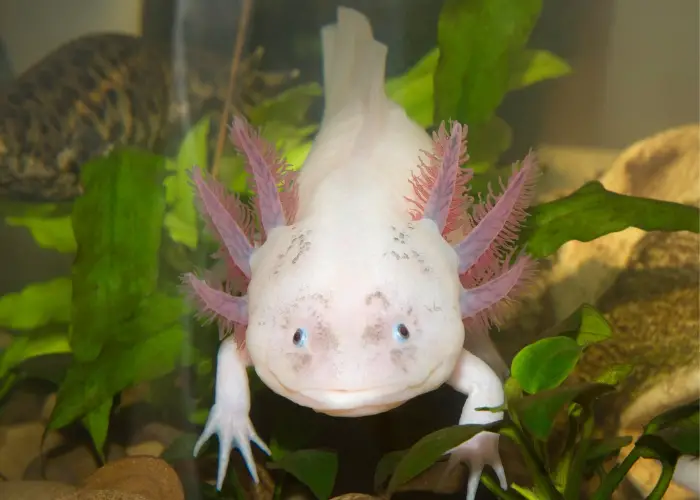
Axolotls, the mesmerizing creatures from the ancient lakes of Mexico, have intrigued scientists, pet enthusiasts, and nature lovers alike with their unique biology and captivating appearance.
While seemingly simple, the question, “Can axolotls breathe air?” opens the door to a deeper understanding of their physiology and evolutionary adaptations.
Yes, they have lungs, and yes, they can breathe air to a certain extent. However, their primary mode of respiration is through their feathery gills, which are adept at extracting oxygen from water.
Their dual respiratory system is a testament to nature’s marvels, but it also serves as a reminder of their vulnerabilities.
Just because they can breathe air doesn’t mean they should be kept out of water for extended periods.
Their aquatic nature is deeply ingrained in their biology, from gills to slender limbs designed for swimming.
For those who choose to bring an axolotl into their homes, owning a pet is not just about owning a pet; it’s about becoming stewards of a unique piece of nature’s puzzle.
Understanding and respect are paramount for all creatures. In their silent, graceful way, axolotls teach us about biology’s intricacies.
They also enlighten us on the responsibilities we bear when we step into the role of caretakers for such exceptional beings.
CHECK OUT MORE AXOLOTL TOPICS BELOW:
- Can Axolotls Live with Turtles?
- Do People Eat Axolotls:
- What Do Axolotls Eat? [Nutritious Food Options]
- Can Axolotls Breathe Air? ( Water’s Whispered Secret! )
- Can Axolotls Live with Turtles?
- Can Axolotls Turn into Salamanders?
REFERENCES:
- Axolotl. (2023, August 23). In Wikipedia. https://en.wikipedia.org/wiki/Axolotl
- Abilene, TX. (n.d.). Axolotl. https://abilenetx.gov/1030/Axolotl
- American Museum of Natural History. (n.d.). Axolotl. https://www.amnh.org/explore/ology/ology-cards/366-axolotl
- Barnett, A. (2019, February 22). Aquatic Axolotls Can Spontaneously Turn Into Air-Breathing Axolotl Morphs. IFLScience. https://www.iflscience.com/aquatic-axolotls-can-spontaneously-turn-into-airbreathing-axolotl-morphs/

